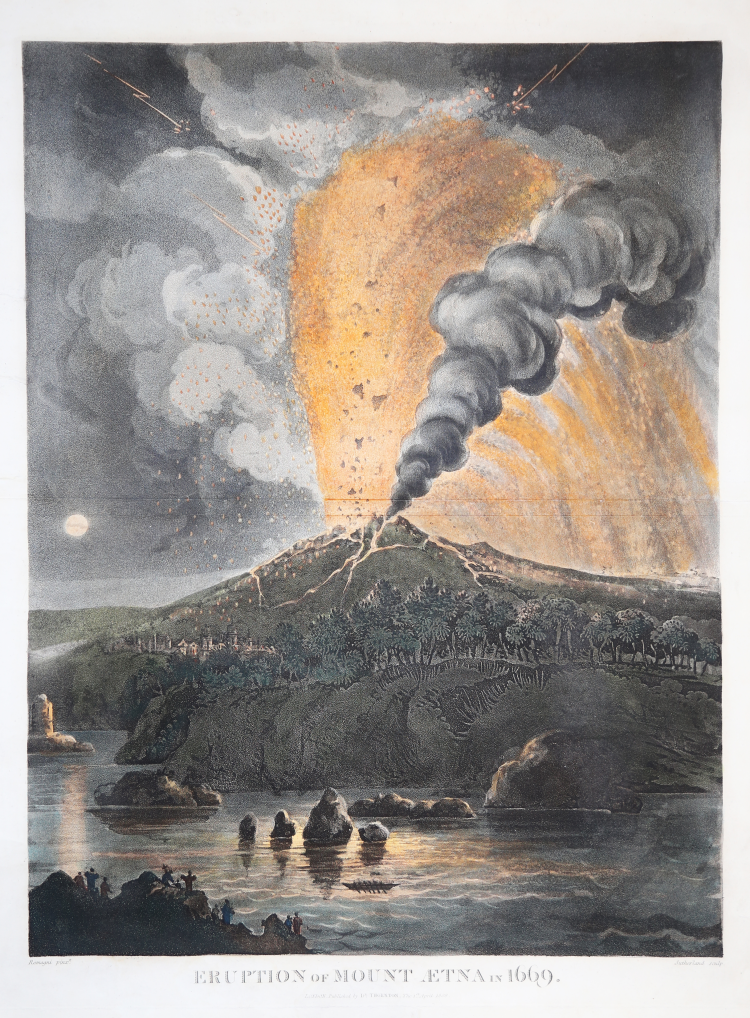



| Reference: | S47191 |
| Author | Robert John Thornton |
| Year: | 1809 |
| Zone: | Etna |
| Printed: | London |
| Measures: | 455 x 595 mm |


| Reference: | S47191 |
| Author | Robert John Thornton |
| Year: | 1809 |
| Zone: | Etna |
| Printed: | London |
| Measures: | 455 x 595 mm |
Eruption of Mount Etna (Aetna) in 1669.
Aquatint printed in colours, made by Thomas Sutherland after a paint by D. Romagni.
Published in 1809 by Robert John Thornton, in the work commonly called The Philosophy of Botany. The longer full title was Botanical Extracts: or Philosophy of botany, being botanical and philosophical Extracts or Elementary botanical plates, illustrative of the science of botany, but more particularly intended to illustrate Botanical Extracts, or the Philosophy of botany.
The images were originallly illustrated by Warner, Sydenham Edwards, Peter Henderson, and Philip Reinagle. The plates were produced using mezzotint and aquatint engraving processes.
Thomas Sutherland (1785–1838) was a British engraver and aquatinter. As well as contributing illustrations to Rudolf Ackermann's The Microcosm of London, he also produced a series of prints based on the Peninsular War.
A fine impression, very good condition. Rare.
Bibliografia
Blunt, The Art of Botanical Illustration, 1950, pgs. 203-208; Johnston, Clevelands Treasures from the World of Botanical Literature, 1998, pgs. 103-105.
Robert John Thornton (1768-1837)
|
Robert John Thornton (1768–1837) was an English physician and botanical writer, noted for A New Illustration of the Sexual System of Carolus Von Linnæus (1797–1807) and "The British Flora" of 1812. He was the son of Bonnell Thornton and studied at Trinity College, Cambridge. Inspired by John Martyn's lectures on botany and the work of Linnaeus, he switched from the Church to medicine. He worked at Guy's Hospital in London, where he later lectured in medical botany. After spending some time abroad, he settled and practised in London. Robert inherited the family fortune after the death of both his brother and mother. In 1799 Thornton commenced his work on the New Illustration of the Sexual System of Carolus von Linnaeus, a work of botanical science to be published in three parts. The first was a dissertation on the sex of plants according to the Swedish scientist Carolus von Linnaeus, and the second an exposition of the sexual system. The most ambitious part of the New Illustration of the Sexual System of Carolus Linnæus was Part III, the Temple of Flora (1799–1807). The first plates were engraved by Thomas Medland in May 1798, from paintings by Philip Reinagle. Between 1798 and 1807, they produced a total of thirty-three coloured plates, engraved in aquatint, stipple and line engraving. When he planned the project, Thornton had decided to publish seventy folio-size plates. Lack of interest from the general public spelled disaster for the scheme, and the holding of a lottery could not save it from financial ruin, neither did a page in the work dedicated to the spouse of George III, Queen Charlotte, patroness of botany and the fine arts. It is estimated that around 800 copies were produced, each containing 31 plates accompanied by inspirational poetry and explanatory notes covering flower lore and legend.
|
Robert John Thornton (1768-1837)
|
Robert John Thornton (1768–1837) was an English physician and botanical writer, noted for A New Illustration of the Sexual System of Carolus Von Linnæus (1797–1807) and "The British Flora" of 1812. He was the son of Bonnell Thornton and studied at Trinity College, Cambridge. Inspired by John Martyn's lectures on botany and the work of Linnaeus, he switched from the Church to medicine. He worked at Guy's Hospital in London, where he later lectured in medical botany. After spending some time abroad, he settled and practised in London. Robert inherited the family fortune after the death of both his brother and mother. In 1799 Thornton commenced his work on the New Illustration of the Sexual System of Carolus von Linnaeus, a work of botanical science to be published in three parts. The first was a dissertation on the sex of plants according to the Swedish scientist Carolus von Linnaeus, and the second an exposition of the sexual system. The most ambitious part of the New Illustration of the Sexual System of Carolus Linnæus was Part III, the Temple of Flora (1799–1807). The first plates were engraved by Thomas Medland in May 1798, from paintings by Philip Reinagle. Between 1798 and 1807, they produced a total of thirty-three coloured plates, engraved in aquatint, stipple and line engraving. When he planned the project, Thornton had decided to publish seventy folio-size plates. Lack of interest from the general public spelled disaster for the scheme, and the holding of a lottery could not save it from financial ruin, neither did a page in the work dedicated to the spouse of George III, Queen Charlotte, patroness of botany and the fine arts. It is estimated that around 800 copies were produced, each containing 31 plates accompanied by inspirational poetry and explanatory notes covering flower lore and legend.
|